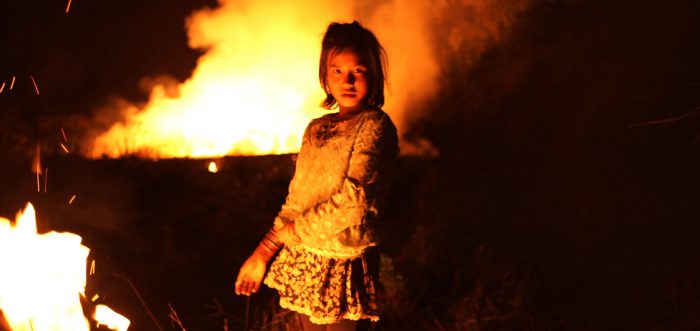
In the last decade and a half every documentary that Wang Bing has released has acted to challenge the nature of the format he works within; testing the limits – and often, going on to break them – of documentary and its modes of expression. His films have worked within seemingly set narrative boundaries yet they’re targeted at an audience often unwilling to engage with the length of many of his works. There’s always going to be a certain rigidity and inaccessibility to the work of a filmmaker who makes their debut with the nine-hour Tie Xi Qu. With Ta’ang, Wang continues his long trend of covering moral issues; shifting away from specific issues of how labour has been manipulated, spread out, and subsequently neglected throughout China, and continuing his move into various areas of intersection. Just as he intimately covered the desolate and mismanaged health system in ‘Til Madness Do Us Part, he does so in Ta’ang with his focus on the refugee crises stemming from China’s particularly complex geopolitical situation in the last century.
Wang’s film tracks a group of refugees, the titular Ta’ang ethnic group, who want to leave Burma after an armed conflict in Kokang forced migration to China. Opening in a Madihe Refugee Camp, on the border between Kokang and China’s Yunnan province, Wang follows and participates in a portion of the group’s journey away from conflict. Wang trades the claustrophobia of ’Til Madness Do Us Part for an overwhelming sense of space in Ta’ang; as we move from Kokang, through various refugee camps, to the city of Nansen; all without Wang letting a trace of his presence appear on screen.
Wang’s documentaries are easier to face with growing familiarity of his work; languishing in long – often initially tedious – takes; not out of a sense of indulgence but more one of emotional transparency and honesty. Ta’ang operates within a certain frame of temporality, as an excerpt of time – inextricably tied to the space in which it is shot. Rather than aiming for overwhelming scope as he did with Tie Xi Qu and ‘Til Madness Do Us Part, there’s something that feels remarkably compact and focused for a 150-minute piece. Wang makes his commentary through implications. The director’s trademark impressionistic editing style is at the heart of this, with an aim to let scenes play themselves out. It creates a work where – scene after scene – the temporality of the circumstances depicted, alongside the fleeting nature of what is played out on screen, creates a document that conveys emotion in the most remarkably human sense.
In this focus he has always put intimacy and honesty at the forefront of his work, however, certain scenes in Ta’ang – particularly those of campfire conversations – have a sense of momentum to them that the more harrowing and confronting shots in ‘Til Madness Do Us Part clearly were unable to provide. Wang’s ability to add mystique to mundanity – or perhaps even, to challenge the audiences perception of ‘mundane’ – is remarkable. At one point Bing captures two men smoking out of handmade bamboo sticks in front of the fire. Their conversation – “You smoke really fast!”, “Really?”, “You do three puffs for every one of mine” – feels revelatory and emotional within the carefully established pacing. In the Daiyingpun Tea Factory we see the process of bamboo harvesting, but Wang follows the effects of this labour – in a scene where two women fall asleep on one another in front of the fire after the short exchange: “I’m tired, but there’s no place to sleep” – “I’ve never felt this sick before.”
Throughout Ta’ang, Wang maintains a sense of pace through his cinematography; from a slower meditative shot of a man smoking expressionless and still through his bamboo shoot – framed by exciting people talking in the foreground, to perhaps the most memorable take in the film: Wang riding in the back of a truck with the family of some of the refugees he has been travelling with into the city of Nansen. Throughout, this ability to remain unseen, to maintain this ‘fly-on-the-wall’ technique, is astounding. It’s difficult to speak about Ta’ang without focusing on how much this trademark approach from Wang has been refined. With such a degree of Wang’s work resting on the process of editing hundreds of hours of footage into a relatively short piece, the technical procedures he follows in removing any remote indication of his presence throughout filming demonstrate the discipline that defines the directors highly defined approach to documentary cinema.
The final scene, shot walking through the hills, is filled with a sense of impermanence, with the vaguely hopeful statement “there should be some shelter up ahead” quickly punctuated by shots in the distance. The intimacy is fully played out; this story, subject and world – initially rigid, slow, and difficult – becomes surprisingly hard to let go of, especially as it concludes with the commentary: “Some of the women and children seen in this film have returned to their homes in Kokang. Fighting in that area continues, bringing new waves of refugees across the border into China.”
With a single title card at the commencement and conclusion of the film, Ta’ang offers itself up as a brief snapshot – and in this, it trades Wang Bing’s more typical sprawling documentaries for a remarkably succinct and fulfilled work. His cinema has always navigated a certain relationship between a humanist, experimental and sociopolitical approach to documentary cinema; as an artist concerned explicitly with intimate portraits of larger moral issues. Like any of his documentaries, Ta’ang is uncompromising. At the same time, the clarity of what Ta’ang wants to be as a film – and the degree to which it achieves this – results in one of Wang’s most memorable and impressive works to date.
